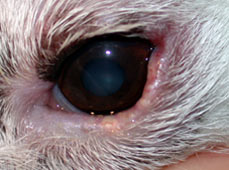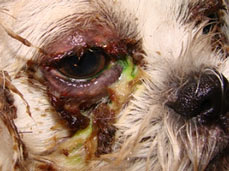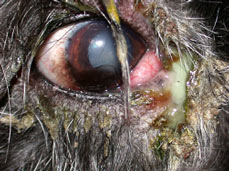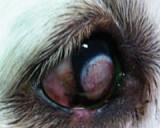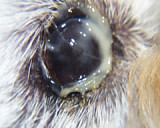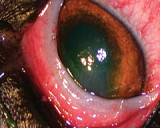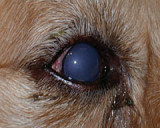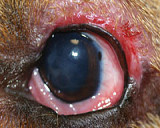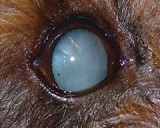Blepharitis is the inflammation of the eyelids. In some cases the eyelids can become extremely swollen, itchy, and/or covered with purulent discharge.
Clinical Signs
Clinical signs of blepharitis
The eyelids are usually quite swollen and thickened. Most have a purulent discharge, which often looks like the discharge associated with dry eye.
Wipe all the discharge away and do a Schirmer Tear Test. The STT is usually increased above normal. The conjunctiva is hyperaemic. Most affected dogs rub at their eyelids.
Less commonly, you may see blepharospasm and corneal ulceration.
Causes
Causes of blepharitis
There are numerous causes of blepharitis. Often we do not find an underlying cause, so we assume that these are caused by allergies.
1. Allergies - atopy or specifically to drugs, soaps, shampoo or food.
2. Bacterial – puppy impetigo or a hypersensitivity to normal bacteria in the skin
3.Solar irritation (solar blepharitis)
4. Insect bites
5. Chemical burns
6.Parasite infections or fungal infection
7. Immune-mediated diseases
8. Nutritional imbalances, i.e. zinc deficiency
9. Endocrine abnormality, i.e. hypothyroidism
10. Secondary to infection associated with eyelid cancer
Diagnosis
Diagnosis of blepharitis
A thorough history and physical examination are essential in trying to work out if there is an underlying cause. Careful examination of the eyelid margins and meibomian gland openings is important. Many cases are caused by blockage of the meibomian gland openings. This usually develops from an allergic reaction or from infection. Swollen and/or impacted meibomian glands might suggest a bacterial infection of the glands. Always perform a Schirmer tear test. The Mucopurulent discharge seen with blepharitis looks exactly like the discharge that you might see with dry eye. Look behind the third eyelid for foreign bodies, as again these may cause a mucopurulent discharge. Check for corneal ulceration.
Treatment
Treatment of Blepharitis
Treatment depends upon the underlying cause. In most cases we do not find an underlying cause. If blepharitis is a result of other ongoing health conditions, these should be concurrently addressed. Warm compresses (hand towels soaked in plain warm water) will aid in removing the discharge from around the meibomian gland openings. This may also reduce the risk of recurrence. The warm Compresses also help to move meibum—the glandular secretions. The hair around the eye can be clipped short to reduce the buildup of discharge. Using Johnson’s No More Tears baby shampoo can be helpful to reduce the amount of debris that can block the meibomian gland openings, and again this may help reduce recurrences.
If no underlying cause is found we usually treat these with oral doxycycline (5mg/kg BID) and prednisolone (1mg/kg SID and taper). Prolonged treatment may be needed. Bacterial blepharitis is treated with antibiotics for a minimum of 3 weeks. In some cases a combined topical antibiotics/anti-inflammatory medication can be applied. If the affected dog has signs of other allergies, referral to a dermatologist may be required.
